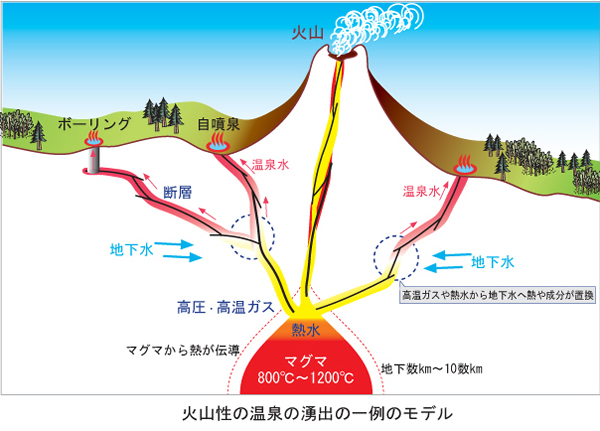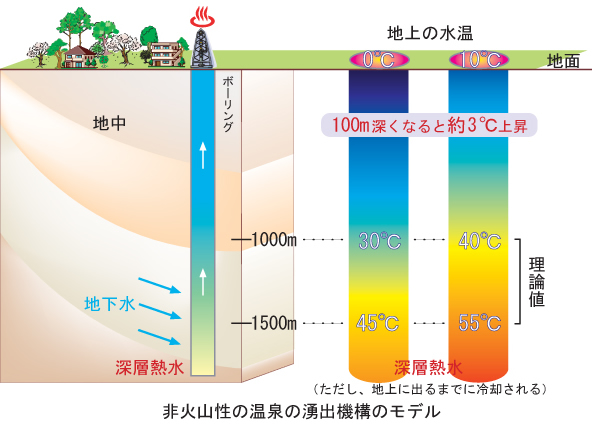Loading...
Please wait while we load your content...
Find the Best Hot Springs in Gifu.
Please wait while we load your content...
For hot springs to form underground, it is necessary for "some form of water to be abundantly present underground," "the underground water to be heated by some source," and "some components to dissolve into the underground water."
Furthermore, for such hot springs formed underground to erupt to the surface, a "pathway such as a fault" connecting the underground to the surface is necessary. Recently, it is common to drill over 1000 meters (deep drilling) and pump up hot springs using power, and in such cases, the drilled hole becomes the pathway for the hot spring.
There are "volcanic hot springs" that erupt in volcanic areas and their surroundings, and "non-volcanic hot springs" that erupt in areas with no volcanoes at all.
Figure 1 is a simple schematic diagram showing an example of the mechanism of volcanic hot springs erupting.

Figure 1: An example of the mechanism of volcanic hot springs erupting
There is a magma chamber located several kilometers to tens of kilometers underground beneath a volcano. The magma chamber contains high-temperature magma (approximately 800°C to 1200°C), high-temperature hydrothermal fluids separated from the magma, high-temperature and high-pressure volcanic gases, steam, etc., which are constantly trying to escape to the surface through weak points such as faults.
Various cracks such as faults in the aquifer, which is a water-retaining stratum, or in the rocks, accumulate groundwater formed by rainwater seeping in. When high-temperature hydrothermal fluids or volcanic gases from the magma chamber come into contact with the groundwater in the aquifer or cracks, heat and various components from the hydrothermal fluids or volcanic gases are transferred into the groundwater, forming high-temperature hot spring water.
Even if the groundwater does not come into contact with hydrothermal fluids or gases, heat can be transferred (conducted) from heat sources such as magma, warming the groundwater.
Since high-temperature hot spring water is lighter than groundwater, it rises through cracks such as faults. Just like water in a pot heated on a stove causes convection, the heat source of the magma causes water convection underground. Therefore, if the cracks such as faults happen to connect to the surface, the hot spring water will naturally erupt to the surface. Additionally, if a borehole is drilled to the cracks storing the "hot spring water" underground, it may be possible to obtain high-temperature hot spring water from deep underground.
Volcanic hot springs in Gifu Prefecture include Hirayu Onsen, Shin-Hirayu Onsen, Fukuchi Onsen, Tochio Onsen, Shin-Hotaka Onsen, Gero Onsen, Shirakawa Onsen, and Hirase Onsen, which is supplied from Shirakawa Onsen.
In addition, there are cases where groundwater is heated by the conduction of heat from high-temperature rock bodies of igneous origin existing underground. Even in areas without prominent active volcanoes, if there is a high-temperature rock body of volcanic origin from ancient times underground, it is known that groundwater can be heated by the conduction of its heat, forming relatively high-temperature hot spring water.
The heat source of Gero Onsen is not clearly understood, but it is suggested that the Yuga-mine volcanic rock body, which is extremely close to the Ontake volcano and is thought to have erupted about 100,000 years ago, has not completely cooled underground and may be the heat source of Gero Onsen.
 |
 |
| Hirayu Onsen, thought to be heated by the Yake-dake volcano | Gero Onsen, thought to be heated by the Yuga-mine volcano |
 |
 |
| Unzen Onsen, a volcanic hot spring in Nagasaki Prefecture | Owakudani Onsen, a volcanic hot spring in Kanagawa Prefecture |
Many of the newly emerging hot spring facilities are located in mountainous or plain areas completely unrelated to volcanoes. Such hot springs have become prominent even in the convenient centers of cities.
Why is it possible to obtain relatively high-temperature hot spring water different from well water in such hot springs?

Figure 2: An example of the mechanism of non-volcanic (deep drilling) hot springs erupting
It is generally known that the temperature increases by approximately 3°C (average value) for every 100 meters deeper underground. This is called the geothermal gradient or geothermal increase rate. Most of the newly emerging non-volcanic hot springs are due to this geothermal gradient, and many hot springs are drilled around 1500 meters to pump out hot spring water (deep thermal water) heated by the geothermal gradient stored deep underground.
However, it is not always the case that high-temperature deep thermal water can be obtained by drilling anywhere; abundant groundwater stored underground is essential.
As shown in Figure 2, since the temperature rises by about 3°C for every 100 meters deeper, theoretically, if you drill around 1500 meters, you can expect hot spring water about 45°C higher than the surface water temperature. However, as the deep thermal water rises to the surface, its temperature decreases, so there are not many cases where high-temperature springs of 42°C or higher erupt.
In the southwestern part of the Nobi Plain, around the estuary of the Kiso Three Rivers, there are many hot springs obtained by deep drilling, and many places have high-temperature springs of 42°C or higher, with some reaching around 60°C. These are characterized by abundant groundwater and a large amount of discharge.
 |
 |
| Kaizu Onsen, where high-temperature springs erupt by deep drilling | Kisomatsu Onsen in Mie Prefecture, where high-temperature springs erupt at the mouth of the Kiso River |
In the underground strata, there may be ancient seawater trapped when the strata were deposited. This is what is called "fossil seawater."
Some non-volcanic hot springs pump up underground fossil seawater through deep drilling. In such hot springs, despite being far from the sea and in places without volcanoes, salty sodium-chloride springs (salt springs) erupt.

Neou Usuzumi Onsen, originating from fossil seawater
Despite the absence of any volcanoes on the Kii Peninsula, many high-temperature springs (springs with a temperature of 42°C or higher) such as Shirahama Onsen, Katsuura Onsen, and Yunomine Onsen are known to exist. Some places even have springs with temperatures close to 100°C.
The heat sources of these high-temperature springs were not well understood. It was thought that the Kumano acidic rock, a Tertiary igneous rock body located near the border of Mie and Wakayama Prefectures in the southern Kii Peninsula, might not have completely cooled and could be the heat source of the springs. However, it was also known that this igneous rock body is from 12 million years ago, leading to the view that it is too old to be considered a heat source.
Arima Onsen in Hyogo Prefecture also has no nearby volcanoes but erupts high-temperature springs close to 100°C, and its heat source was not well understood. Recently, research by the National Institute of Advanced Industrial Science and Technology revealed that the hot spring water of Arima Onsen originates from high-temperature hydrothermal fluids generated by dehydration of rocks constituting the Philippine Sea Plate subducting beneath the Japanese archipelago, as reported in newspapers.
Similarly, reports by groups led by Susumu Nishimura and Kazuhiro Amida suggest that the high-temperature springs in the Kii Peninsula and Oita Prefecture also originate from dehydration of the Philippine Sea Plate.
When a plate is formed near the seabed, a lot of seawater is simultaneously incorporated. As the Philippine Sea Plate subducts deeply beneath the Japanese archipelago, high pressure causes dehydration of the plate's rocks. The "water" generated by rock dehydration is high-temperature hydrothermal fluid at several hundred degrees Celsius, and when it is generated at about 100 km underground, it rises and melts the mantle rocks above to form magma. However, the hydrothermal fluid originating from Arima Onsen is generated at a shallow depth of 40 km to 80 km, so it does not form magma and rises to the surface as hydrothermal fluid. The high-temperature hydrothermal fluid generated by the plate, as it rises to the surface, mixes with groundwater, decreasing in temperature and becoming hot spring water.
 |
 |
| Source of Arima Onsen in Hyogo Prefecture | Source of Shirahama Onsen in Wakayama Prefecture |